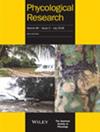干燥对被低估的褐藻和红藻的影响:生物活性的改变
IF 1
4区 生物学
Q2 MARINE & FRESHWATER BIOLOGY
引用次数: 5
摘要
根据生物活性水平,如抗氧化和抗炎特性,评估了干燥对两种棕色海藻(Treptacantha abies - marina和Cystoseira humilis)和两种红色海藻(armata天冬酰胺和taxxiformis天冬酰胺)的影响。此外,还测定了一些重要化合物类别的含量,如多酚和β -葡聚糖。无论干燥过程如何,海苔C. humilis和T. abies‐marina的多酚含量都很高(1.76-6.78 mg没食子酸当量g−1 dw),明显超过天冬酰胺属。这部分反映在DPPH和FRAP法测定的抗氧化活性中,结果表明,在大多数情况下,黄芽草和野田笋的提取物比天冬酰胺的提取物具有更强的抗氧化活性。干燥技术对抗氧化活性的影响相对有限,因为在许多情况下没有影响。在抗炎活性方面,在阴凉干燥的情况下,黄草比阿玛塔具有更高的活性(约30%的COX - 2抑制)。然而,这种活性在黄芽孢杆菌的上胃肠道中是不存在的。事实上,只有A. taxformis在上消化道中显示出抗炎活性,显示上消化道的可用性在90-100%范围内。因此,尽管天冬酰胺类植物的生物活性水平较高,但天冬酰胺类植物也含有大量的生物活性化合物。日光干燥比遮荫干燥产生更多的负面影响,但这些影响不是很广泛。本文章由计算机程序翻译,如有差异,请以英文原文为准。
The effect of drying on undervalued brown and red seaweed species: Bioactivity alterations
The effect of drying on two brown seaweed (Treptacantha abies‐marina and Cystoseira humilis) and two red seaweed species (Asparagopsis armata and Asparagopsis taxiformis) was evaluated based on the levels of biological activity, such as antioxidant and anti‐inflammatory properties. Moreover, the contents of some significant compound classes, such as polyphenols and beta‐glucans, were determined. Seaweeds C. humilis and T. abies‐marina showed high polyphenol levels (1.76–6.78 mg gallic acid equivalents g−1 dw), which clearly exceeded those determined in the Asparagopsis genus regardless of drying process. This was partially reflected in the antioxidant activity as measured by DPPH and FRAP methods, which showed that extracts from C. humilis and T. abies‐marina in most cases had stronger antioxidant activity than those from Asparagopsis species. The influence of the drying technique upon the antioxidant activity was relatively limited, since in many instances there was no effect. Concerning anti‐inflammatory activity, in the case of shade‐dried samples, C. humilis had a higher activity (>30% COX‐2 inhibition) than A. armata. However, this activity in C. humilis was not rendered available in the upper gastrointestinal (GI) tract. Indeed, only A. taxiformis displayed anti‐inflammatory activity in the fraction available in the upper GI tract, showing an upper GI tract availability in the 90–100% range. Therefore, though bioactivity levels were higher in C. humilis and T. abies‐marina, Asparagopsis species also had substantial levels of bioactive compound. Sun‐drying produced more negative effects than shade‐drying, but these effects were not very extensive.
求助全文
通过发布文献求助,成功后即可免费获取论文全文。
去求助
来源期刊

Phycological Research
生物-海洋与淡水生物学
CiteScore
3.60
自引率
13.30%
发文量
33
审稿时长
>12 weeks
期刊介绍:
Phycological Research is published by the Japanese Society of Phycology and complements the Japanese Journal of Phycology. The Journal publishes international, basic or applied, peer-reviewed research dealing with all aspects of phycology including ecology, taxonomy and phylogeny, evolution, genetics, molecular biology, biochemistry, cell biology, morphology, physiology, new techniques to facilitate the international exchange of results. All articles are peer-reviewed by at least two researchers expert in the filed of the submitted paper. Phycological Research has been credited by the International Association for Plant Taxonomy for the purpose of registration of new non-vascular plant names (including fossils).
 求助内容:
求助内容: 应助结果提醒方式:
应助结果提醒方式:


